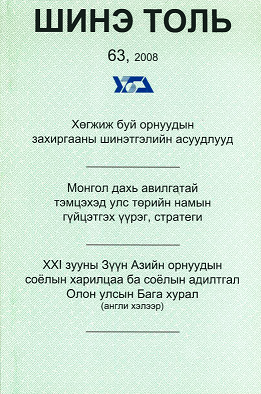![]()
Luvsanjamts Lkhamiin
/Mongolian University of Science and Technology/
Шинэ толь №63, 2008
Argunemt for local governments
There are several arguments to have strong local governments in any states either it is federal or unitary. The first arguments refer to Public Finance issues as followings. Local governments’ control of money and public service improves the efficiency and effectiveness of public spending because the people who need the services are determining. Local people could involve on decisions of amount of the public services and determining its priority through the democratically elected local governments. This is more efficient and transparent system for public finance control. Local governments pay more attentions by their own interests on collections and managing local taxes, fees, and charges. The second arguments are Economic Growth such as strong local governments are necessary to improve the enabling environments for local businesses; to develop local infrastructure; to give local talent a reason for staying home; to slow out-migration from rural jurisdictions; to partner with donors and the state to ensure that aid money is spent on projects and infrastructure that are really needed.
General Power Relations between Central and Local Government in Mongolia
Mongolia is divided administratively into aimags and a capital city, and aimags in turn are divided into soums, soums into bags, the capital city into districts, and districts into horoos (precincts).
Each administrative and territorial unit has its subject citizens, and citizens form local self governing organizations that represent them, Hurals. or citizens representative organizations are Citizens’ Representative Hurals (CRH) – a form of democratic representation – at aimag, the capital city, soum and district levels, and Citizens’ Common Hurals (CCH) – a form of direct democracy – at bag and horoo levels. During the intermission of these hurals, presidium operates.
The Constitution states that the governance of administrative units shall be implemented by combining self governance with state administration, and the state administration responsibilities of this principle should be implemented through Governors while local self governance functions through representation of CRHs.
This consititutional provision is probably worth stating and really does not create an autonomous sphere of responsibility for local governments and as such, really does not recognize the fundamental principle of local governance. It is ambiguous by design.
CRHs are the citizens’ representative organizations of a given administrative units that are directly and democratically elected by the people. ln this context, they should bear full political responsibility’ before the residents. But in reality they are not bearing this responsibility.
The status of governor is defined in the Constitution as to implement given unit’s hural decisions as well as perform central government representative functions in the local area, and bear responsibility before upper instance governor and the government.
Also the Constitution states that the governor has a veto authority on decisions of a corresponding aimag, capital city, soum, district, bag or horoo Hural decisions. If the veto is dismissed by the majority votes of the Hural members, and the governor deems that the decision cannot be implemented, the governor can submit the his/her resignation request to corresponding Hural, Prime Minister and higher instance governors.
Looking at the above mentioned legal status of local governance from the political power allocation point, it is unclear whether it is the governor or CRHs who bear ultimate political responsibility. As they represent the state, governors shall be accountable to higher instance governors or Prime Minister.
But it is unclear what kind of responsibility governors bear in local politics. As they are nominated by CRHs which in turn are elected from the people, it is obvious they should bear some responsibility in local politics, but they also have powers to veto decisions of the organization to which they are accountable to (CRHs).
It is also unclear in laws which issues they have a power to veto. Also, veto resolution mechanism is such that can lead to an impasse for a given issue.
interviews were conducted with governors, CRH chairmen, secretaries, and other administration and Hural representatives of selected aimags and soums under this study. On the question ‘Who has more power, governor or CRH?’, 80 percent of interlocutors answered as governor, 15 percent as both have the same powers, and five percent as CRH.
Especially, interlocutors consider governors more powerful than CRHs in budget and finance administering, and appointing and managing local personnel.
Also, the majority of interlocutors view that governors represent more state administration and its functions than local governance. And the majority of interlocutors CRHs should play more important role in the local area than governors.
Further, on the question ‘How clear is the issue of allocation of powers and functions between governor and CRHs, the majority of local governors and representatives replied as unclear.
The answers to the above questions indicate that it is unclear whether governors or CRHs are the ultimate responsibility bearing subject in local governance. Powers to manage, organize and make decisions over local budgets, finances, and human resources have become more concentrated in the hands of governors who represent state functions and interests rather than in local self governing organizations.
On the question ‘Are local administrative organizaions have more power than CRHs?’ of the survey covering representatives of local CRHs and administration employees, the majority or about 70 percent answered that local administrative organizations or governor office’s administrations have more power than CRHs. This evaluation is the same for all administrative units such as aimags, the capital city, soums and districts.
The Mongolian reality of local government legal provision make sense as following similarity “unclear de jure, pretty clear de facto… meaning the unclear principles of local government in the law are clearly being violated in practice”
Concluding all these, today in Mongolia local governance serves as a local branch of central government’s centralized management system.
All level governors are the positions for direct local implementation of country’s unified government’s functions. In this context, governors represent higher instance governors and the government rather than bear responsibility in from of local self governing organizations. Therefore, this position is closer to the notion of local authority than a united representation of state administration and local self governance principles.
Local administrative organizations, though dubbed as ‘self governing’, in reality serve to governors than to Hurals. Because local administration organizations are headed by governors, they are endowed with more powers to bridle personnel policies, appoint people to main official positions, resolve organizational issues, and administer budget funds at the local level. On these issues, there is almost no trully independent power allocated to Hurals.
Also, it is common that administration officials such as given aimag or soum governors, governor office department heads, employees and heads of agencies subordinate to governors get elected as members of CRHs. This situation weakens monitoring of governors activities by Hurals, reducing the possibility of decision making of local self governing organizations independently of interests of administration officials. For instance, in 2000-2004, out of 35 representatives to the CRH of Tuv aimag, there were 14 soum governors, one soum CRH chairman, one independent member, and nine public servants of aimag or soum governor’s office administrations. One interlocutor politician was questioning if local self governing organizations with such representation can work for the interests of citizens instead of working for governors.
On the other hand, CRHs that are self governing bodies selected from the people can influence to certain extent to powers of governors to issue legislative acts and by approving their budgets and discussing performance reports, but have no power to veto their decisions. Even approving local budgets is in fact just the approval of subsidies allocated by the central government to local goverments. That local budgets are not independent and directly dependent on the center weakens roles and responsibility of local self governing bodies.
Do hurals determine the use of a budget set by higher levels, are lots of the revenues already earmarked for specific functions, are they essentially presented with a complete budget and told, approve this, or else.
Largely insufficient powers of local Hurals in terms of planning, budgets and finances, human resources and organization result in ineptness of their activities. This situation weakens participation of local people in state service distribution, organization and monitoring and discredits the idea of local democracy
Territorial unit governance is dominated by the central government’s program, has low level of local participation, and operates under strictly top-to-bottom structure.
Interlocutors view that local government’s powers in regard to budgets and finances decreased after approval of Law on Public Sector Management and Financing in 2002. Primary and secondary education and health service financing is now the direct responsibility of sector ministries whereas in the past the state provided financing and local authorities were responsible for delivering the services.
This reforms are viewed by the government as ensuring the possibility of spending budget funds under unified management, in a controlled nd efficient way, but they are not so much consistent with local interests.
Agencies subordinate to local governors sometimes receive their budgets directly from ministries, creating incentives for getting out of governor’s management. Especially appointment of the heads of these agencies becomes more an issue of interests of central government’s ministries rather than local governments.
Specifically, people defining local policies view that these reforms weakened incentives for activities of all level governors and CRHs, sometimes creating inflexible structures under which it is impossible to make decisions on certain issues locally, and strengthening centralized public management system with top-to-bottom direction.




